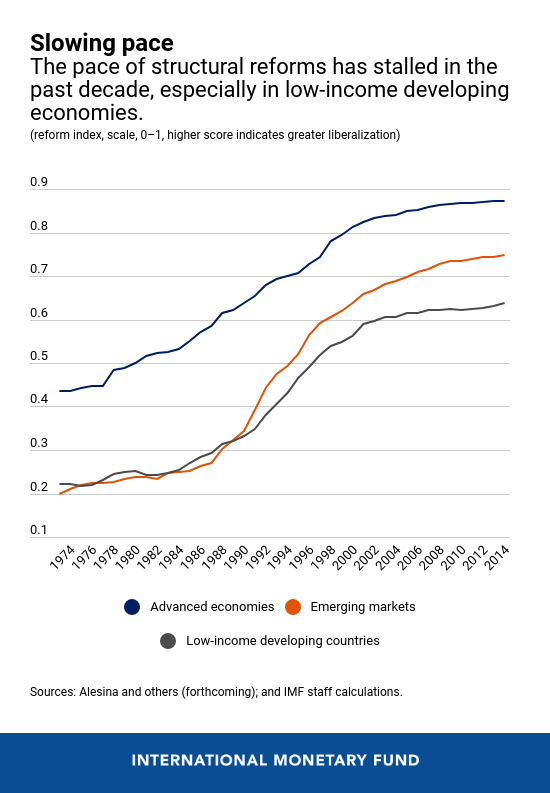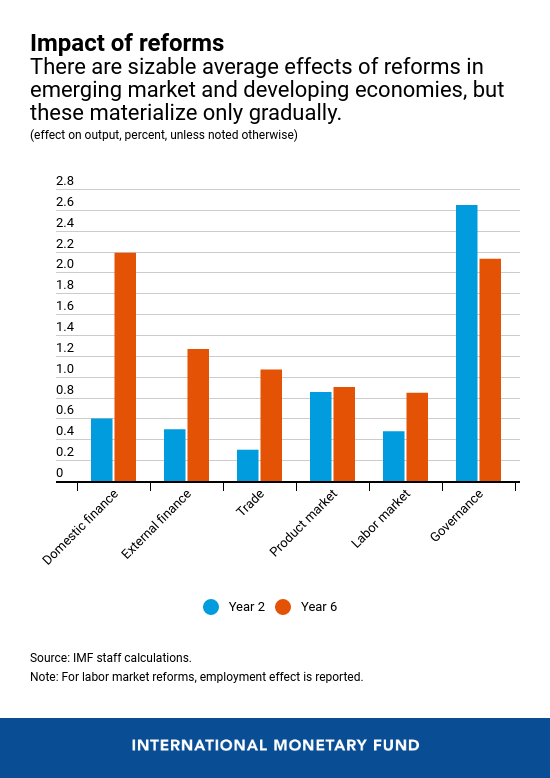عربي, 中文, Español, Français, 日本語, Português, Русский
Emerging markets and developing economies have enjoyed good growth over the past two decades. But many countries are still not catching up with the living standards of advanced economies.
At current growth rates, it would take more than 50 years for a typical emerging market economy to close half of its current income gap in living standards, and 90 years for a typical developing economy.
Our research in Chapter 3 of the October 2019 World Economic Outlook finds that implementing major reforms in six key areas at the same time—domestic finance, external finance, trade, labor markets, product markets, and governance—can double the speed of income convergence of the average emerging market and developing economy to the living standards of advanced economies. This could raise output levels by more than 7 percent over a six-year period.
Structural reforms can yield sizable payoffs.
More room for reforms
Policies that change the way governments work—known as structural reforms—are difficult to measure. They often involve policies or issues that are not easy to quantify, such as job protection legislation or the quality of supervision of the domestic banking system.
To address this, the IMF recently developed a comprehensive dataset covering structural regulations in domestic and external finance, trade, and labor and product markets. The data cover a large sample of 90 advanced and developing economies during the past four decades. To the five indicators, we added the quality of governance (for example, how countries control corruption) from the World Governance Indicators.
The new indicators show that, after the major wave of reforms in the late 1980s and—most importantly—the 1990s, the pace slowed in emerging market and developing economies during the 2000s, especially in low-income developing countries.
While this slowdown reflects the prior generation of reforms, as in advanced economies, there remains ample room for a renewed reform push, particularly in developing economies—notably, across sub-Saharan Africa and, to a lesser extent, in the Middle East and North Africa and the Asia-Pacific region.
Reforms can boost growth and living standards
Based on our empirical research of reforms in 48 current and former emerging markets and 20 developing economies, we find that reforms can yield sizable payoffs. But these gains take time to materialize and vary across different types of regulations. For example, a domestic finance reform of the size that took place in Egypt in 1992 leads to an increase in output of about 2 percent, on average, six years after implementation. We get a similar result for anti-corruption measures, whose effects are sizable in the short run and stabilize at around 2 percent in the medium term. In the other four reforms areas—external finance, trade, product markets, and labor markets—the gains are about 1 percent six years after the reform.
For the average emerging market and developing economy, the results imply that major simultaneous reforms across all six areas considered in this chapter can raise output by more than 7 percent over a six-year period. This would increase annual per capita GDP growth by about 1 percentage point, doubling the average speed of income convergence to advanced-country levels. Model-based analysis—which captures the longer-term effect of reforms and provides insights on the channels through which they affect economic activity—points to output gains about twice as large as the empirical model over the longer term (beyond 6 years).
One channel through which reforms increase output is by reducing informality. For example, lowering barriers to businesses’ entry in the formal sector encourages some informal companies to become formal. In turn, formalization boosts output by increasing companies’ productivity and capital investment. For this reason, the payoff from reforms tends to be larger where informality is pervasive.
Getting the timing, packaging and sequencing right
Some reforms work best when the economy is strong. In good times, reducing layoff costs makes employers more willing to hire new workers, while in bad times it makes them more willing to dismiss existing ones, magnifying the effects of a downturn. Similarly, increasing competition in the financial sector at a time of weak credit demand may push certain financial intermediaries out of business, further weakening the economy.
In countries where the economy is weak, governments may prioritize reforms—such as strengthening product market competition—that pay off regardless of economic conditions, design others to alleviate any short-term costs—such as enacting job protection reforms now with a provision that they will take effect later. These reforms can also be accompanied with monetary or fiscal policy support where possible.
Reforms also work best if properly packaged and sequenced. Importantly, they typically deliver larger gains in countries where governance is stronger. This means that strengthening governance can support economic growth and income convergence not just directly by incentivizing more productive formal enterprises to invest and recruit, but also indirectly by magnifying the payoff from reforms in other areas.
Finally, to fulfill their promise of improving living standards, reforms must be supported by redistributive policies that spread the gains widely across the population—such as strong social safety nets and programs that help workers move across jobs. For reforms to be sustainable and therefore effective, they need to benefit not just some, but all.






